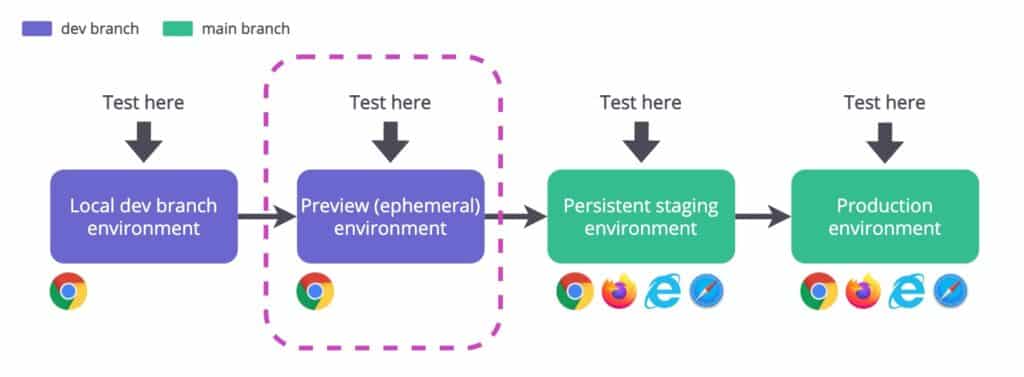3 Tips for Implementing Ephemeral Environments in Your Dev Team

For software project managers, enhancing the productivity of their development teams is only half the battle. They also need to look at the development process itself. The more you capitalize on opportunities to streamline things, the more efficient they become and the better your teams will be.
This is a major part of the reason why ephemeral environments have become such an invaluable resource for development teams over the years. They can help dramatically improve resource efficiency, help ensure a better sense of consistency, and even bolster security – all at the same time.
Of course, as is true with any other tool in this setting, success has less to do with the tool itself and is more about how that tool is ultimately used. When it comes to implementing ephemeral environments in your development team, there are a few key things to keep in mind.
Table of Contents
Ephemeral Environments and Testing
One of the most important use cases for ephemeral environments is the testing process and the major efficiency gains that can be made as a result.
When teams still operate using a traditional software development approach, code changes are first sent to staging or quality assurance environments for testing. Things are worked on in this vacuum, and if issues are discovered, they are addressed immediately. The process is effective in a technical sense… but it is also time-consuming. Oftentimes, if a project is going to experience delays, it’s a result of something going wrong here.
On the other hand, this doesn’t have to be the case with ephemeral environments. Individual software developers can create their own temporary, siloed environments to test their code changes whenever needed. It’s a far better way for teams to work, especially during the “remote” era when most people likely won’t be in the same area at the same time to begin with. People can be productive when they need, wherever they need.
In addition to reducing the amount of time it takes for testing, it also streamlines the amount of effort. Testing can happen on multiple branches simultaneously and developers don’t actually need to involve anyone else if they don’t expressly want to. More importantly, no issues discovered during the tasting process will cause any other issues elsewhere in production. Developers can proceed knowing that all code changes are reliable and of high quality, leading to one less potential source of headaches throughout the software development project.
The Backbone of the Development Process
Another key thing to remember when implementing ephemeral environments in your development team is that it is a great opportunity to containerize your code.
While it’s true that most people think of microservices when they think of containerized code, there are other use cases here, too. Making an effort for true containerization helps ensure that the application environment you and your team are working on includes everything from binaries to libraries to environment variables and more, allowing it all to run on a standard container runtime.
Again, this makes it easy to implement new features and test certain portions of the application without impacting the larger whole. Developers can work on their own tasks simultaneously without worrying about A) holding anybody up and throwing the entire time off schedule and B) potentially making the type of error that could hurt what everyone else is doing.
Team members can work essentially in a silo, all before the individual parts they’ve been working on are compiled together into a larger whole. It’s a far more efficient way for the software development process to take shape, and it’s one that is definitely easier with ephemeral environments at your side.
Continuous Integration and Deployment Pipelines: Additional Considerations
Finally, don’t neglect the fact that ephemeral environments are highly shareable by design. In the short term, this makes it easier for multiple team members to collaborate with one another to solve a challenge or tackle a pressing issue. In a larger sense, this allows developers to work together on the same code base at the same time – all without letting issues like compatibility between different systems get in their way.
This type of sharing in terms of ephemeral environments can become a major part of your continuous integration and continuous deployment pipelines, otherwise known as CI/CD. Code changes can be automatically tested and deployed to production environments faster than ever.
In addition to helping to eliminate the risk of errors, it also helps prevent unnecessary downtime as well. Any issues that do develop can be resolved quickly, all before they have a chance to impact other members of the team (or worse, end users).
Ephemeral environments are nothing if not malleable – they can help a great deal depending on what you’re trying to accomplish in the moment. They’re highly scalable and the perfect way to unlock the productivity benefits that only automation brings with it.
However, you must follow best practices like those outlined above – particularly as it relates to testing, development, and continuous integration/deployment pipelines. Only then will ephemeral environments become another piece of the puzzle that helps project managers and their team members optimize workflows and foster more organic collaboration than ever before.
This leads to a scenario where embracing ephemeral environments properly helps accelerate innovation, reduce downtime, and achieve greater agility in a software project. All these things contribute to a higher quality end product and a more satisfied client.








